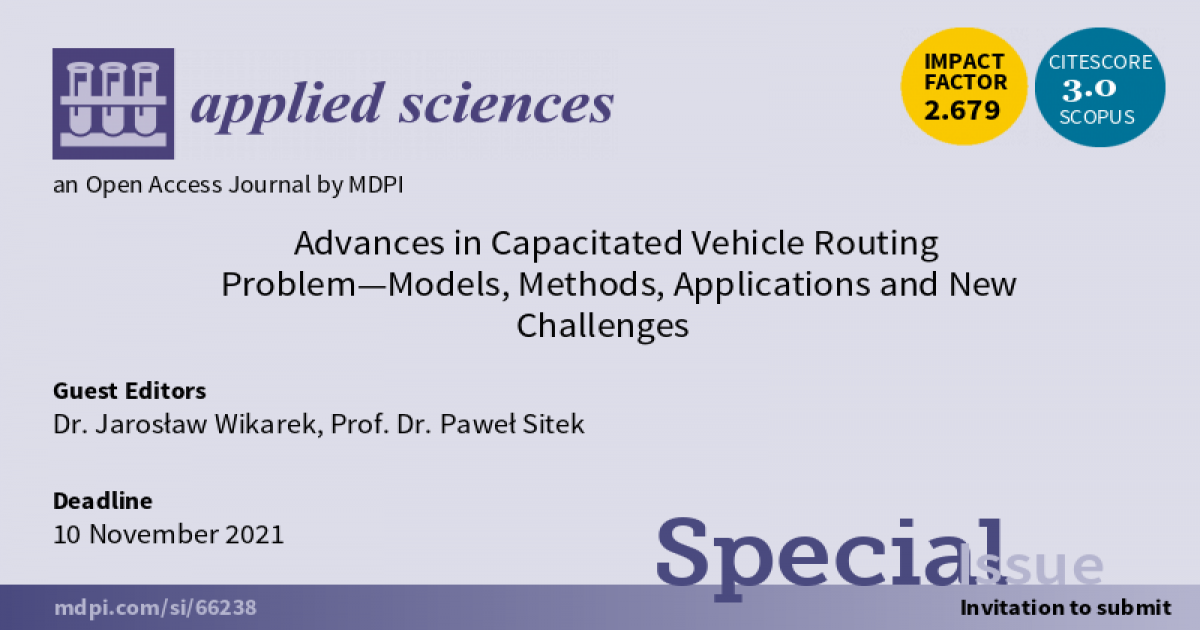Advances in Capacitated Vehicle Routing Problem—Models, Methods, Applications and New Challenges
A special issue of Applied Sciences (ISSN 2076-3417). This special issue belongs to the section "Transportation and Future Mobility".
Deadline for manuscript submissions: closed (10 November 2022) | Viewed by 51146

Special Issue Editors
Interests: modeling and solving problems with constraints in manufacturing, distribution, logistics, etc.; decision support; optimization; artificial intelligence
Special Issues, Collections and Topics in MDPI journals
Interests: constraint programming; operation research; optimization; decision support; logistics; manufacturing; supply chain management
Special Issues, Collections and Topics in MDPI journals
Special Issue Information
Dear Colleagues,
The capacitated vehicle routing problem (CVRP) is a key to efficient distribution, transportation and supply-chain coordination. In broad terms, it deals with the optimal assignment of a set of transportation tasks to a fleet of vehicles and the sequencing of stops for each vehicle. Currently, due to the development of means of transport, the concept of a vehicle is much broader (AVG, UAV, EV, etc.). The CVRP has a large number of real-life applications and comes in many variants, depending on the type of task, the objective, the time frames and the types of constraints that must be met. The CVRP is a computationally hard discrete optimization problem. Outside of transportation, logistics and supply chains, the CVRP has less intuitive but still important applications, e.g., in robotics and manufacturing.
For this Special Issue titled “Advances in Capacitated Vehicle Routing Problem—Models, Methods, Applications and New Challenges”, we invite authors to submit articles that take up the discussion and present solutions in the field of models, methods, applications and new challenges for the CVRP.
Dr. Jarosław Wikarek
Prof. Dr. Paweł Sitek
Guest Editors
Manuscript Submission Information
Manuscripts should be submitted online at www.mdpi.com by registering and logging in to this website. Once you are registered, click here to go to the submission form. Manuscripts can be submitted until the deadline. All submissions that pass pre-check are peer-reviewed. Accepted papers will be published continuously in the journal (as soon as accepted) and will be listed together on the special issue website. Research articles, review articles as well as short communications are invited. For planned papers, a title and short abstract (about 250 words) can be sent to the Editorial Office for assessment.
Submitted manuscripts should not have been published previously, nor be under consideration for publication elsewhere (except conference proceedings papers). All manuscripts are thoroughly refereed through a single-blind peer-review process. A guide for authors and other relevant information for submission of manuscripts is available on the Instructions for Authors page. Applied Sciences is an international peer-reviewed open access semimonthly journal published by MDPI.
Please visit the Instructions for Authors page before submitting a manuscript. The Article Processing Charge (APC) for publication in this open access journal is 2400 CHF (Swiss Francs). Submitted papers should be well formatted and use good English. Authors may use MDPI's English editing service prior to publication or during author revisions.
Keywords
- Supply chains
- Urban transportation
- Last-mile logistics
- Allocation of resources
- Multi-modal processes
- AI-driven approach to modeling and solving CVRP
- UAV fleet routing and scheduling
- Milk-run systems
- Dynamic routing and scheduling
- Fuzzy CVRP
Benefits of Publishing in a Special Issue
- Ease of navigation: Grouping papers by topic helps scholars navigate broad scope journals more efficiently.
- Greater discoverability: Special Issues support the reach and impact of scientific research. Articles in Special Issues are more discoverable and cited more frequently.
- Expansion of research network: Special Issues facilitate connections among authors, fostering scientific collaborations.
- External promotion: Articles in Special Issues are often promoted through the journal's social media, increasing their visibility.
- Reprint: MDPI Books provides the opportunity to republish successful Special Issues in book format, both online and in print.
Further information on MDPI's Special Issue policies can be found here.






